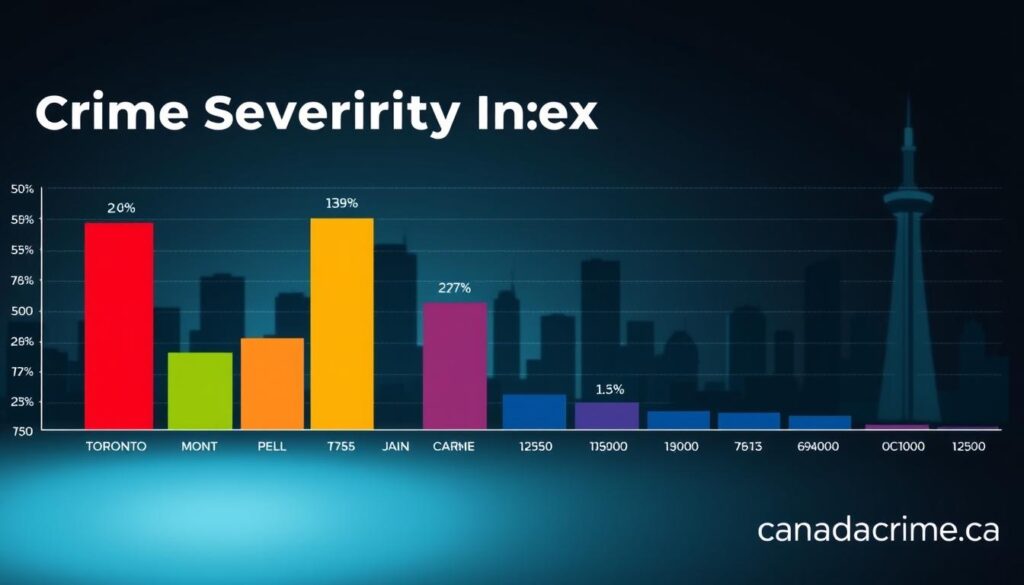Canada, known for its safety, faces crime challenges in certain areas. According to recent statistics, some cities experience higher crime rates due to socioeconomic factors and population density.
Exploring the crime rates across Canada reveals a complex picture. The Crime Severity Index (CSI) is a crucial metric used by Statistics Canada to measure and compare crime across different regions.
This analysis will examine the current state of crime in Canada, focusing on the factors contributing to higher rates in specific cities and the implications for law enforcement and community safety.
Understanding Crime Measurement in Canada
Understanding how crime is measured in Canada is crucial for analyzing crime trends and patterns across different regions. Crime measurement is fundamental to developing effective crime prevention strategies and policies.

Crime Severity Index Explained
The Crime Severity Index (CSI) is a statistical measure that reflects the volume and severity of crime in Canada. It is calculated based on the number of crimes reported to the police, weighted by their seriousness. The CSI provides a more nuanced understanding of crime trends than traditional crime rates, as it takes into account the relative severity of different crimes. For instance, violent crimes are given more weight than property crimes. According to Statistics Canada, the CSI has become a valuable tool for law enforcement and policymakers to assess crime patterns and allocate resources effectively.
“The Crime Severity Index is a critical metric that helps us understand the true impact of crime on Canadian communities.” By analyzing the CSI, researchers and law enforcement can identify trends and patterns that may not be apparent through traditional crime rate analysis.
How Crime Rates Are Calculated
Crime rates in Canada are typically calculated as the number of criminal incidents per 100,000 population. This standardization allows for comparison between communities of different sizes. The calculation involves dividing the total number of criminal incidents reported to the police by the population of the area, then multiplying by 100,000. Statistics Canada collects data from police services across the country, ensuring consistent reporting standards and methodologies for national comparability. Crime rates can be calculated for specific offense categories or as an overall measure of total criminal incidents.
Factors such as reporting rates, police resources, and demographic characteristics must be considered when interpreting variations in crime rates between different communities. By understanding these factors, analysts can gain a more accurate picture of crime trends and develop targeted strategies to address them.
Top 10 Cities with the Highest Crime Rate in Canada
Certain Canadian cities are plagued by high crime rates, making them a concern for residents and law enforcement. Understanding the crime dynamics in these cities is crucial for developing effective crime prevention strategies.

Red Deer, Alberta
Red Deer, Alberta, is known for having one of the highest crime rates in Canada. With a Crime Severity Index (CSI) significantly higher than the national average, the city faces challenges related to both violent and non-violent crimes.
Kelowna, British Columbia
Kelowna, a major city in British Columbia, experiences a high volume of property crimes, contributing to its elevated CSI. The city’s crime profile is characterized by a mix of violent and non-violent offenses.
Saskatoon, Saskatchewan
Saskatoon is another city with a notably high crime rate, driven in part by violent crimes. The city’s CSI reflects the need for targeted crime reduction initiatives.
Winnipeg, Manitoba
Winnipeg faces significant crime challenges, with a high incidence of both violent and property crimes. The city’s crime rate is a concern for residents and law enforcement alike.
Regina, Saskatchewan
Regina, like Saskatoon, experiences a high crime rate, with a notable portion attributed to violent crimes. Efforts to address these issues are ongoing.
Richmond, British Columbia
Richmond’s crime profile is unique, with a high CSI driven primarily by non-violent crimes. Despite a lower violent CSI, the city’s overall crime rate remains a concern.
- Richmond presents a unique crime profile among Canada’s most dangerous cities, with non-violent offenses driving its high Crime Severity Index of 121.2, while its violent CSI is comparatively lower at 66.2.
- The British Columbia municipality has reported 2,255 index crimes in 2024 to date, with property crimes constituting the majority of these incidents.
- Aggravated assault remains Richmond’s most prevalent violent crime with 465 occurrences, though this category is overshadowed by the volume of property offenses.
- The city’s 787 larceny-theft cases and 619 vehicle thefts highlight the significant challenges with property crime that residents and businesses face.
- Homicides remain relatively rare in Richmond with only eight recorded killings this year, demonstrating that despite its high overall crime ranking, the most serious violent offenses occur less frequently than in some other high-crime Canadian cities.
Crime Patterns in Major Canadian Metropolitan Areas
Major Canadian metropolitan areas exhibit diverse crime patterns influenced by local socioeconomic factors. Understanding these patterns is crucial for developing effective crime prevention strategies.
Vancouver’s Crime Landscape
Vancouver, a major metropolitan area in British Columbia, has its unique crime challenges. While it is considered a safe city compared to some other major Canadian cities, Vancouver still faces issues related to property crime and violent offenses. The city’s crime rate is influenced by factors such as its port activity, tourism, and socioeconomic conditions. Recent statistics indicate that Vancouver is working to address these challenges through community-based initiatives and law enforcement strategies.

Edmonton and Calgary Comparison
Edmonton and Calgary, Alberta’s two major cities, present contrasting crime profiles. Edmonton has a higher crime rate and crime severity index (CSI) compared to Calgary. Edmonton’s CSI stands at 106.2, significantly higher than Calgary’s, and is among the highest for major Canadian cities. Despite a 7.2% decrease in Edmonton’s overall crime rate, the crime severity increased by 4.6%, indicating more serious offenses. In contrast, Calgary maintains a more moderate crime profile, with a CSI more comparable to eastern Canadian cities like Montreal.
The disparity between Edmonton and Calgary highlights the influence of local factors, including enforcement strategies, social services, and economic conditions, on crime patterns. Calgary, being the larger city, has a different crime landscape, suggesting that city-specific factors play a significant role in shaping crime rates.
Provincial Crime Rate Rankings
Crime rates across Canadian provinces and territories show a mixed picture, with some regions having much higher crime severity indexes than others. Understanding these provincial crime rate rankings is crucial for developing effective crime management strategies.
Territories with the Highest Crime Rates
The territories in Canada are known for having the highest crime rates. The Crime Severity Index (CSI) is a valuable tool for measuring the relative severity of crime in different regions. According to recent data, the territories consistently rank high in the CSI, indicating a more significant crime problem compared to the provinces.
The high crime rates in these areas can be attributed to various factors, including socioeconomic challenges and the remote nature of many communities, which can complicate law enforcement and social services delivery.
Safest Provinces in Canada
On the other end of the spectrum, some provinces stand out for their low crime rates. Quebec, Ontario, and Prince Edward Island are notable for having some of the lowest Crime Severity Indexes in the country.
- Quebec consistently ranks as Canada’s safest province with a Crime Severity Index of 54.3.
- Ontario, despite having several cities with high crime rates, maintains the second-lowest crime rate among provinces, with a CSI of 56.2.
- Prince Edward Island benefits from its small, tight-knit communities and lower urban density, contributing to its low crime rate, with a CSI of 57.0.
These provinces demonstrate effective crime management strategies, often combining community-based initiatives with robust law enforcement practices. The success of these regions provides valuable insights that can be adapted to areas with higher crime rates.
| Province/Territory | Crime Severity Index |
|---|---|
| Prince Edward Island | 57.0 |
| Ontario | 56.2 |
| Quebec | 54.3 |

Understanding the Canadian Crime Code

Understanding the intricacies of the Canadian Crime Code is essential for grasping how crimes are categorized and prosecuted in Canada. The Criminal Code of Canada is a comprehensive legal framework that outlines the various offenses and their corresponding penalties, playing a crucial role in the country’s criminal justice system.
Major Criminal Code Offenses
The Canadian Criminal Code categorizes offenses into different types based on their seriousness and the procedures for prosecution. Major criminal code offenses include violent crimes such as assault and homicide, as well as non-violent crimes like theft and fraud. These offenses are further classified into indictable and summary offenses, with indictable offenses being more serious and carrying harsher penalties.
For instance, violent crimes like assault are taken very seriously and can result in significant time in prison. The classification of these crimes depends on various factors, including the severity of the offense and the perpetrator’s intent.
Classification of Crimes
The Canadian criminal justice system employs a dual classification of crimes system, categorizing offenses as indictable, summary, or hybrid. Indictable offenses are more serious and involve formal procedures, potentially leading to trial by judge and jury. Summary offenses are less serious and are processed more expeditiously with limited penalties. Hybrid offenses allow for prosecutorial discretion in determining how to proceed.
Crimes are also categorized by type, primarily distinguished between violent and non-violent offenses. Violent crimes are those that cause harm or threat to individuals, while non-violent crimes involve offenses against property or public order. The Crime Severity Index further refines this classification by assigning weights based on the seriousness of offenses as determined by actual sentencing patterns in Canadian courts.
Violent vs. Non-Violent Crime Distribution
Understanding the dynamics between violent and non-violent crimes is crucial for addressing Canada’s crime issues effectively. The distinction between these two categories is not just a matter of legal definition; it reflects fundamentally different challenges for law enforcement and community safety.
In Canada, crime rates vary significantly across different jurisdictions, with some areas experiencing higher levels of violent crime and others grappling with property crime issues. The Crime Severity Index (CSI) is a valuable tool for understanding these variations, as it weights crimes according to their seriousness.
Violent Crime Hotspots
Certain cities in Canada have been identified as having higher rates of violent crime. These hotspots often require targeted interventions to address the underlying causes of violence. For instance, factors such as socioeconomic conditions, substance abuse, and gang activity can contribute to higher rates of violent crime.

Property Crime Trends
Property crime constitutes the majority of criminal offenses in most Canadian jurisdictions. Theft under $5,000, breaking and entering, and vehicle theft are among the most common categories. Cities like Richmond and Kelowna have shown particularly high rates of property crime relative to violent offenses. For example, Richmond reported 787 larceny-theft cases and 619 vehicle thefts, highlighting significant property crime problems.
The “weighted clearance rate” for property crimes typically lags behind that of violent offenses, with national averages showing only about 25-30% of property crimes resulting in charges, compared to 60-65% for violent crimes. However, some jurisdictions have seen improvements; Red Deer reported a 27.8% decrease in property crimes over a two-year period, demonstrating the effectiveness of targeted enforcement and prevention strategies.
Factors Contributing to Highest Crime Rate in Canada
Examining the underlying causes of Canada’s highest crime rates reveals a intricate interplay of socioeconomic factors and substance abuse. The complex relationship between these factors and crime rates is crucial to understanding and addressing the issue effectively.
Socioeconomic Factors
Socioeconomic factors play a significant role in shaping crime rates across Canada. Communities with lower socioeconomic status often experience higher rates of crime due to factors such as unemployment, poverty, and lack of access to education and job opportunities. For instance, areas with high unemployment rates tend to have higher rates of property crimes as individuals may resort to criminal activities to meet their basic needs.
| Socioeconomic Factor | Impact on Crime Rate |
|---|---|
| Unemployment | Higher rates of property crimes |
| Poverty | Increased likelihood of criminal activity |
| Lack of Education | Reduced job opportunities, higher crime rates |
Substance Abuse and Crime Correlation
Substance abuse maintains a strong correlation with criminal activity across Canada, contributing to both direct drug-related offenses and crimes committed to support addiction. The opioid crisis has dramatically impacted crime patterns in many community areas, with overdose-related emergency calls increasing nearly fivefold in some regions between 2019 and 2023. For example, in the Confederation Suburban region and the Fairhaven neighborhood, “sharps incidents” and overdose events have surged, with fire department calls rising from 289 in 2019 to 1,395 in 2023.
The use of methamphetamine presents particular challenges for law enforcement due to its association with unpredictable and sometimes violent behavior, contributing to both property and rates violent crime. The relationship between substance abuse and crimes creates complex challenges for the criminal justice system, as traditional enforcement approaches often fail to address the underlying health aspects of addiction.

Communities implementing comprehensive approaches that combine enforcement, treatment, harm reduction, and prevention have shown the most promising results in addressing the substance abuse-crime nexus. By understanding the correlation between substance abuse and rates violent non-violent crime, law enforcement and community organizations can develop targeted strategies to reduce crime and improve community safety.
Crime Rate Trends: 2020-2024
Analyzing crime rate trends from 2020 to 2024 reveals significant shifts in Canada’s crime landscape. According to Statistics Canada, the crime severity index has shown varied trends across different cities.

Impact of the Pandemic on Crime Rates
The COVID-19 pandemic had a profound impact on crime patterns in Canada. Between 2020 and 2022, many cities experienced fluctuations in their total crime rate. For instance, Winnipeg saw a significant increase in crime severity by 20%, while Edmonton recorded a 7.2% decrease in its overall crime rate.
Despite these variations, the pandemic highlighted the resilience of certain crime categories. As noted by law enforcement officials, “The pandemic has accelerated the shift towards technology-facilitated crimes, including fraud and cybercrime.”
Recent Changes in Crime Patterns
Recent crime data indicates a concerning trend towards increased crime severity, driven by rising violent offenses and weapons-related crimes. Auto theft has emerged as a particularly problematic category, with organized criminal groups targeting specific vehicle models for international export.
The divergence between the total crime rate and the crime severity index in cities like Edmonton, where the rate decreased by 7.2% while severity increased by 4.6%, indicates a shift towards more serious offenses. Additionally, the decline in weighted clearance rates for property offenses reflects the challenges faced by law enforcement agencies in solving high-volume crimes.
As the crime landscape continues to evolve, understanding these trends is crucial for developing effective crime prevention strategies. The index scores provide valuable insights into the changing nature of crime in Canada.
Canada’s Safest Cities and Communities

The safety records of Canadian cities vary, with some consistently ranking as the safest. These cities are characterized by low crime rates and high standards of safety.
Top 5 Safest Urban Areas
The top 5 safest urban areas in Canada are known for their low crime rates and strong community policing. These cities include:
- Cities with strong economic fundamentals
- Urban areas with effective community policing models
- Cities that incorporate Crime Prevention Through Environmental Design (CPTED) principles
What Makes These Cities Safe
Several factors contribute to the safety of these cities. Strong economic fundamentals, including low unemployment rates and diverse employment opportunities, play a significant role. Additionally, effective community policing and well-developed social infrastructure are crucial. Municipal planning that incorporates CPTED principles also helps deter criminal activity.
Furthermore, community engagement and social cohesion foster environments where residents actively participate in maintaining community safety. These factors combined create a safe and secure environment for residents.
Crime Prevention Strategies in High-Risk Areas
Crime prevention in high-risk Canadian areas requires a multi-faceted approach. Effective strategies involve both community-based initiatives and advanced law enforcement techniques.
Community-Based Initiatives
Community-based initiatives play a vital role in preventing crime. These programs focus on building trust between law enforcement and the community, providing support to at-risk individuals, and promoting social cohesion. By engaging with local residents and organizations, police services can better understand and address the root causes of crime.
- Neighborhood watch programs
- Youth mentorship initiatives
- Community outreach and education
Law Enforcement Approaches
Law enforcement agencies in Canada are adopting innovative approaches to combat crime. Intelligence-led policing models utilize data analysis to identify crime patterns and deploy resources effectively. Specialized units address specific crime challenges, such as gang activity and domestic violence.
| Law Enforcement Approach | Description |
|---|---|
| Intelligence-Led Policing | Utilizes data analysis to identify crime patterns |
| Specialized Units | Addresses specific crime challenges |
| Community Policing | Emphasizes relationship-building and problem-solving |

Conclusion: The Future of Crime Management in Canada
As the Canadian crime landscape continues to shift, innovative and collaborative approaches to crime management are becoming increasingly important. Canada remains one of the safest countries globally, but certain regions struggle with higher crime rates and severity indexes.
The future of crime management in Canada will be shaped by technological advancements, including artificial intelligence and predictive analytics, which will enhance both prevention and response to criminal activity. Moreover, addressing the underlying social determinants of criminal behavior will be crucial.
Key factors influencing future strategies include the need for increased collaboration across government levels and sectors, and the impact of climate change on public safety. By adopting a comprehensive approach that balances enforcement with prevention, Canada can continue to improve its crime management. This multifaceted strategy will be vital in maintaining Canada’s safety profile and addressing emerging challenges in the year to come, ultimately reducing crime rates and enhancing public safety.

